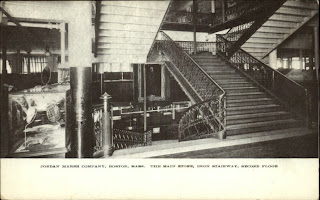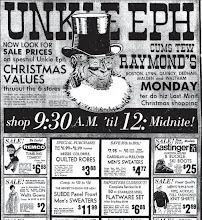Let me start by saying that today’s update is NOT about business trends and financial matters!
I could have called this update by many witty titles...but it really tired my brain to try to be so clever!
The update today is all about (a concise “all about”, mind you) the art and style of in-store travel within our beloved stores of Boston’s rich retailing past.
A discussion and sharing of memories about elevators in the various Boston stores came up a few weeks ago on the Facebook feeder page to this blog and this inspired me to delve into the world of travelling conveniences provided by the stores of yesteryear.
A tiny bit of building history is in order now. Pencils ready!!!
The large retail stores of Boston were mostly started as smaller retail businesses in little old buildings with only a few floors above the street level....if any.
After the GREAT FIRE of 1872, many retailers migrated into what we now call...Downtown Crossing and began building larger, multi-floored establishments..... “retail houses” as they were often called back then. These mercantile establishments grew and prospered....thus creating the wonderful department stores of the Boston we all knew and loved.
The upward move after 1872 to build five or more selling floors created some issues. How do we get the customers (think back to those gowns the ladies wore in the late 1800’s) up to the various floors with ease and comfort?

The stairs were fine...to a point....very few merchants wanted the women folk walking up more than one or two sets of stairs at most. The passenger elevator had been perfected as “safe” in the mid- 1800’s but they were not very common in Boston until after the fire of 1872. Stores installed these early hydraulic and steam driven elevators as soon as the new buildings went up. They were faster than stairs and if controlled by a careful operator, they provided a safe and smooth ride up and down.
The stores in Boston, as you will soon see, rushed to provide the latest elevators with increasing speeds and perfect comfort...and sheer numbers in operation per store. The move in the late 1800’s to electric powered motors gave way to even speedier trips between the sales floors.
At the turn of the century another new, rather scary, device came along....the escalator or moving stairs or electric stairs as they were referred to at various times in the 20th century. This new “toy” caused much fear and confusion. So much so that instructions on safe ridership needed to be given as these new fangled machines became part of the standard fare found in most of the bigger stores in our city and in the "new" MTA.
Some stores eventually gave way to the new, ultra- modern phase....those utilitarian machines known as “automatic elevators” from the 1950’s onward.
I now provide a selection of stores of old and a few facts and memories about how they each introduced safe, stylish and speedy travel within their great walls. Enjoy these...they were so much fun to research!


Jordan Marsh:
The old Main Store of Jordan Marsh on the corner of Washington and Avon Streets had elevators installed in the later part of the 1800’s. These were located originally in the center of the store and were considered slow by the changing technologies of the 1890’s. Newer, faster ones were installed during the 1890’s in several banks...one set near Avon Street and the other closer to Summer. These ran from basement to the upper floors with greater speed and comfort. The store also boasted a “Grand Staircase” of ornamental iron from the mid-1890’s....but it was more ornamental than functional for customers who wanted to get from the street floor to the fourth in record time. By 1898, Jordan Marsh had eleven elevator cars running in just the Main Store alone...the Annex had not been added yet. During the early part of the 1900’s, Jordan’s added the Annex on the other side of Avon Street and it also had many (about 13) elevators whisking you from basement to the ninth floor in no time at all. Jordan Marsh was slow to join the trend of installing escalators into its buildings. Most of the bigger stores of the day had them but Jordan’s was slow to put faith in them. Safety issues plagued these devices...and many customers feared them. Jordan Marsh bit the bullet in the late 1930’s and finally installed nearly a full set of “electric stairs” in the Annex. These went from the basement to the fifth floor. These were very modern (for the late 1930’s) electric stairs because they were reversible...all up...at opening times....all down...for closing and a mix of ups and downs in between times! The electric stairs in the Annex were memorable for a few reasons...they were slightly off -kilter on some floors and you had to walk a bit to get from one set to another AND they were plagued with accidents involving children because of the fact Jordan’s famed TOYLAND was on the fifth floor of the Annex and a delightful stopping point for many a child visitor. In the late 1950’s, Jordan Marsh even offered an “Ups and Downs” course for children on safe escalator use....this was hosted in the Peabody store. The great building project of 1949 to 1957 saw Jordan Marsh grow and consume the rest of the Summer Street block with a huge new building made up of three joined units. This modern building had large, cockpit style controlled elevators and speedy escalators from top to bottom...they were lined up properly, by the way. The cockpit style elevator provided a little raised area in the corner for the operator to stand and work the mechanisms. Jordan Marsh maintained elevator operators in most of its many buildings until the closure of the Annex in 1978. Automatic elevators took over in the rebuilt parts of the store from this stage onward. Gone were the gloved women in uniforms who met you with a smile as you entered the ornamental sliding doors of each elevator in the old Main Store and the Annex. The cockpit elevators in the 1949 section of the new building were converted to automatic at some stage by the 1970’s. One lasting memory for me of the “old” Jordan Marsh is the way the elevators zipped up and down as I stood waiting for my mother to look at the various counters of the street floor in the old Main Store. You could see inside the shafts through the attractive metal and glass doorways and watch as the cars went up and down....as a young child this view held my attention for ages. I can tell you now...they did “zip”...for old operator based elevators they did give you a exciting jolt as you sped up and swooped down. A treat for the youth of Boston...now just a treasured memory for some of us lucky enough to be just that little bit older.

Filene’s :
Filene’s boasted an early escalator as well as elevators in the old buildings on Washington Street on the opposite corner from the 1912 Burnham masterpiece. The 1912 move to the purpose built Burnham Building brought a host of fast, smooth elevator cars and an escalator from the street floor to the second. Filene’s Basement offered no elevator or escalator service as part of its cost saving theme until the early 1970’s when the escalator finally descended downward to the great bargain bazaar. A full set of escalators was installed from street floor to top in the early 1950’s and the first automatic elevators marched in 1958.
R.H. White’s:
White’s was always ahead of its time. The new building it had built in the 1870’s was a trend setter for department stores of the day. The early installation of the “Jumbo” elevator in the late 1800’s served as a major step UP. It could safely transport about 50 passengers in each trip...no other store of the day boasted such a device. The “Jumbo” was in use for a good number of years before being retired. White’s also was the first Boston store to use a “moving stairway” from street floor to second in the very early days of the 1900’s. It was a real crowd pleaser and many came to just to watch...it was a true novelty for the next few years until other stores provided the service as well as the up and coming MTA. White’s did provide training on how to ride it safely....many early patrons wanted to sit on it as they thought it would be safer that way. In the 1940’s, modern escalators were installed from street floor to fifth....White’s needed to keep up with Jordan Marsh next-door who just added new escalators to the Annex. When Raymond’s moved in 1966 and took over the building...they finally had an escalator (a high speed one, too) and were thrilled to have moved up in the retailing world.
Gilchrist’s:
The company did have elevators in the buildings prior to the large new building of 1912...when the new building opened, keeping up with Filene’s opposite them, they boasted new improved in-store travel service and a greater number of cars than previously offered. The new building did soar up ten floors and numerous, quick elevators were a BIG must for happy customers. The store never had the space or desire for an escalator service....but they did begin to introduce new, high-speed automatic elevators in the very early days of the 1960’s. The gloved operators were gone by the end of that decade....sadly!
Please enjoy these various advertisement, articles and photos from many stores of our retro Boston as they show–off various travelling technologies to a more than eager public.
http://www.flickr.com/photos/24334155@N03/
Ps...Don't forget....I am still working on my Jordan Marsh memory project. Write me!!!!







































3 comments:
Great topic! I vaguely remember elevator operators in stores. The sliding accordion gates and the calling out the items sold on each floor.
I used to L-O-V-E riding the elevators @ Jordan's and remember how they had the floor numbers (combined with those arrows guiding you to the next set of escalators) embedded into the floors, guiding you in the right direction on your great escalator adventure
Its a gr8 site! I got lots of information about shopping through online! I'm going to share this with my facebook friend right now.
Thanks,
Anneler Günü Hediyesi
Post a Comment